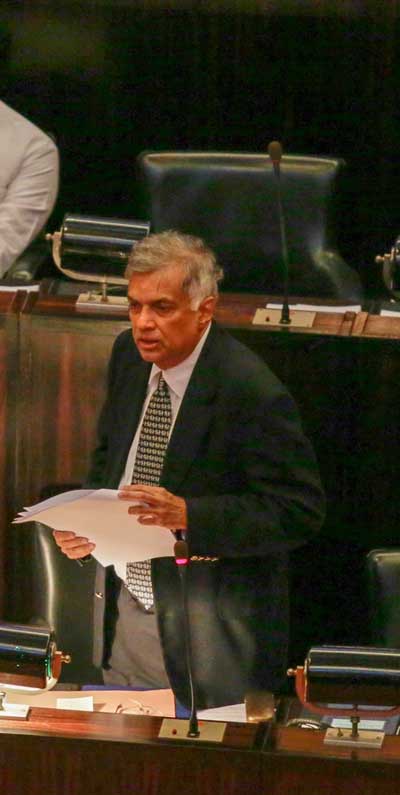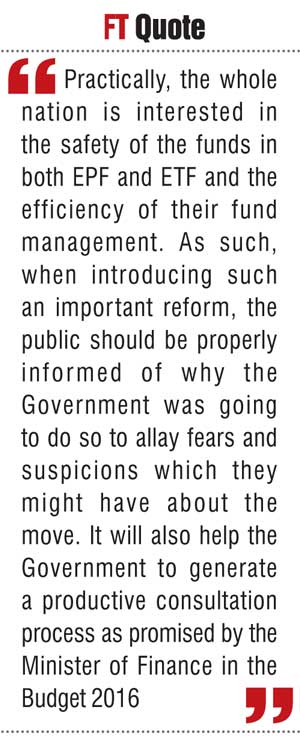Sunday Dec 07, 2025
Sunday Dec 07, 2025
Monday, 25 January 2016 00:02 - - {{hitsCtrl.values.hits}}
 Trade unions up in arms against the proposed merger of EPF and ETF
Trade unions up in arms against the proposed merger of EPF and ETF
In a recent live television discussion on ITN, the President of the Ceylon Bank Employees Union, also known as CBEU, made a very strong case against the proposed merger of the Employees Provident Fund or EPF and Employees Trust Fund or ETF into a separate board and taking EPF fund management away from the Central Bank of Sri Lanka (available at: http://www.itn.lk/2016/01/19/kawuda-eththa-kiyanne-2016-01-19/).
The proposal to merge them had been made by Prime Minister Ranil Wickremesinghe in the Economic Policy Statement or EPS delivered in Parliament last year. Finance Minister Ravi Karunanayake reconfirmed the Government’s wish to do so in Budget 2016 presented to Parliament two weeks later, promising to consult trade unions before doing so.
The rationale not explained
The rationale for making such merger had not been presented either in the EPS or Budget 2016 leaving all those who have an interest in these two funds in the dark completely. Nor was there any subsequent communication from the Prime Minister’s Office or the Ministry of Finance enlightening the public of the reasons for the proposed merger and taking EPF away from the Central Bank.
Sans vital information, it is quite natural for trade unions to suspect the whole move as yet another instance of some unsavoury hand working to rob the moneys belonging to the working people of the country. Hence, all trade unions have been up in arms against the proposed merger.
There was the Government Medical Officers’ Association or GMOA which did not have direct interest in EPF or ETF but still protested against the proposed merger in an apparent expression of solidarity with the other trade unions in the country. The CBEU, according to its President who appeared on TV, was against the proposed merger because all its members were contributors to the ETF and some members to EPF as well. Hence, to protect the interests of its members, the CBEU was against the proposed merger and would do everything possible in collaboration with other trade unions to stop the Government’s move.
Economic reform programs should be well-publicised
The proposed merger is a major economic reform affecting practically 10 million workers of the country and their families because the two funds carry a fraction of what they have saved for their old age. If the funds are lost, they lose an avenue for old age social security as well. In addition, employers too have a direct interest in the two funds because they too have supported their build up by contributing to protect the old age security of the people who had helped them to prosper while they had been in their employment.
Hence, practically, the whole nation is interested in the safety of the funds in both EPF and ETF and the efficiency of their fund management. As such, when introducing such an important reform, the public should be properly informed of why the Government was going to do so to allay fears and suspicions which they might have about the move. It will also help the Government to generate a productive consultation process as promised by the Minister of Finance in the Budget 2016.
But, in the absence of any such initiative on the part of the Government, it is inevitable that the public, which is in the dark, would become easy prey to self-serving machinations orchestrated by interested parties. Forming public opinions based on views expressed only by one party is the biggest threat to the proper functioning of economic policy governance in any country.
Objections by trade unions
The objection to the proposed merger by trade unions is based on two convictions. One is that they have full faith in the Central Bank in managing EPF and therefore, moving it from away the Central Bank could mean nothing but disaster.
The second is that they have a legitimate fear that it is a ruse used by politicians to rob their moneys in the two funds. The first conviction, it appears, would have been formed without taking the full facts into consideration. But, given the track record of the two funds in the recent past, one cannot blame the trade unions for forming the second conviction.
To understand the issues at hand properly, it may be necessary to go back to the history of the two funds in question.
Creating a freak structure in EPF
The need for setting up a retirement benefit scheme in the style of a national provident fund for the private sector workers in the country was first mooted by the Sir Ivor Jennings Commission in 1944 when it reported on the ways to provide relief to needy people in colonial Ceylon. Having accepted this recommendation, the post independence governments had initiated action to draft legislation to set up a provident fund for private sector employees. However, the actual establishment of the provident fund was done 14 years after its first recommendation in 1958 by the Bandaranaike Government that came to power in 1956.
In designing the structure of the fund, the Government had liberally drawn on the Employees Provident Fund in Malaysia and the Central Provident Fund in Singapore but with a major difference. Both these funds had been set up as statutory boards with administration, account-keeping and fund management functions under the purview of the respective boards.
However, in Sri Lanka, instead of setting up the fund as a statutory board, a weird and unworkable structure was created. Accordingly, the administration of the EPF Act was assigned to a government department, namely, the Department of Labour. The money collection, account-keeping and fund management part was assigned to the Monetary Board of the Central Bank, a measure that does not sit well with its normal functions.
The temporary measure becoming a permanent measure
When the draft bill to set up a ‘national provident fund’ was announced in 1956, the late N.U. Jayawardena, a former Governor of the Central Bank and then a Senator, made a strong protest to the Government arguing that it was not a part of the job of the Central Bank and it would amount to reducing the Central Bank to the status of a government department, according to a report published in the Ceylon Daily News.
Prime Minister Bandaranaike had, according to the same report, appeased N.U. by that it would be a temporary measure to hand over these functions to the Central Bank. However, this temporary measure had remained a permanent measure over the last 57-year period bringing enormous complications for the effective administration of the fund. This awkward arrangement, it appears, is similar to outsourcing the money collection, account-keeping and fund management functions of the EPF to the Central Bank by the legislators of the country.
Central Bank’s good track record in the past
There was a good reason for Prime Minister Bandaranaike to rely on the Central Bank for the management of the funds of the EPF. As revealed in the Parliamentary debate in enacting the EPF Act, there was no other institution in the country at that time that could be relied on for the safety of the funds belonging to the workers of the country.
The Central Bank had a track record of being an independent institution free from political interference since its establishment in 1950. That right of the bank had been respected by the political parties in power too. Hence, as if foreseeing a potential threat to the EPF funds, Prime Minister Bandaranaike had wanted to keep it at a safe distance away from the future politicians or other interested parties.
It appears that he did not trust in future politicians. Accordingly, the governance structure created in the EPF administration gave sole authority to the Monetary Board of the Central Bank to decide on how the moneys should be invested. There was no role played by the Labour Commissioner or the Minister in charge of Labour in advising the Monetary Board in doing so. The only requirement was that the Monetary Board should publish the accounts of the EPF in a fairly detailed form and get the concurrence of the Minister of Labour and Minister of Finance to the interest rate payable to members.
Bandaranaike had trusted that the Monetary Board would do a professional job, free from outside interferences, in handling the moneys belonging to the working population of the country. In fact, the Monetary Board had lived up to these expectations for most of the period in the past and it is this safety record maintained by the Monetary Board that has indelibly been marked into the DNA of trade unions. That is why trade unions get nervous and frightened when it is suggested to divorce the EPF’s long marriage to the Central Bank.
ETF was to achieve democratic socialism by creating a share-owning working class
ETF, on the other hand, was created in 1981 to facilitate the private sector workers to own shares of private companies through contributions made by employers on their behalf. Hence, it is similar to an Employee Share Ownership Plan or ESOP implemented at the national level. Since it permits workers to own shares of companies, it is tantamount to establishing ‘socialism through democratic means’.
However, in actual practice, while the ETF has invested a small part of its funds in company shares, the bulk of its resources has been invested in government Treasury bills and Treasury bonds. Hence, instead of establishing democratic socialism, ETF has simply helped successive governments to run deficit budgets by financing the same. Trade unions today should, therefore, ask ETF to go back to its original mission and allow its members to own companies.
Administrative difficulties in EPF structure
What the trade unions have not realised are the enormous administrative difficulties created by the present structure of EPF and ETF. In the case of EPF, the division of functions between the Central Bank and the Department of Labour has created coordination and implementation problems.
This is not a problem concerning the particular officers in the two institutions who are all driven by a common public spirit. Yet, a government department functioning under restrictive administration and financial regulations cannot work with the same speed and efficiency as an institution that is free from them. Hence, when a modernisation program is designed for EPF involving both the Labour Department and the Central Bank, it is always fraught with delays, failures and losses. That is why the EPF has not been able to bring itself up to the level of the best managed provident funds in other parts of the world. It is the members of the trade unions who suffer and not the Labour Department or the Central Bank.
EPF and ETF inconveniencing everyone
The functioning of EPF and ETF as two different institutions has also inconvenienced both workers and employers and created an inefficient structure within the national economy. After retirement, workers have to apply to two institutions to get back the moneys belonging to them. Employers have to file two returns, write two cheques and track two types of accounts. In the national economy, two computer systems and two regulatory mechanisms have to be wasted to maintain the same member accounts and enforce compliance by employers. These are unnecessary hassles that could be avoided if both EPF and ETF are amalgamated into a single social security board.
Hence, the proposed move by the Government is for the benefit of all these parties concerned. The only requirement is to place the money in the hands of the people who would do a professional job.
However, a national economy cannot rely on individuals. It has to rely on establishing a proper institutional system and effective governance structure in which those who handle the moneys belonging to the workers are made accountable for their actions.
Central Bank’s failure in the recent past
Trade unions have trusted the Central Bank for the safety of their moneys, a kind of built-in DNA in their system. However, this has not been the case with regard to the Central Bank in the past 5 to 6-year period.
The last Annual Report which the Central Bank has published for EPF has been in respect of 2012 though it is early 2016 today. This is a strange development since annual reports are released in printed form even by large banks with accounts exceeding 10 million in number within three months of the close of the financial year.
Even the Central Bank publishes its own annual report within four months of the end of the calendar year. Trade unions, civil society and members have been kept in the dark with respect to the EPF’s activities in the recent past. In this regard, the track record of ETF too has not been better. It too has published its last Annual Report only for 2012, according to its website, www.etfb.lk. Thus, the members of both institutions cannot trust the governance structure of these two institutions.
Using EPF reserves to declare high interest rates
An anomaly in the EPF Act has been the creation of the fund without a capital base. Hence, if any investment goes sour, there is no mechanism to absorb the losses. In terms of the EPF Act or the Monetary Law Act under which the Central Bank has been set up, the Monetary Board of the bank has no liability to meet those losses. The EPF Act does not provide for the Government to bear these losses either. Hence, it is the EPF members who have to absorb the losses arising from bad investments by agreeing to a cut in the interest income or the balance in the account.
If investments going sour are large in a particular year, the losses to members too would be unbearable. The Monetary Board, having taken this into account, commenced building internal reserves from 1998 without distributing the entirety of the surplus among members. These reserves were built up to Rs. 48 billion by 2010.
However, according to the EPF Annual Report for 2012, these reserves have been depleted by Rs. 29 billion in an unsound practice of declaring a higher interest rate to members to show that the EPF had been doing well in the market. Since no accounts have been published since 2012, the current position is unknown.
Mis-investment of EPF funds by the Central Bank
What the unions do not know is that the Monetary Board has used EPF moneys to invest in unsound companies and acquire ownership in commercial banks. When EPF decided to allocate a small portion of its resources for buying high value shares in public companies in 1998, two conscious decisions were made by the Monetary Board.
One was to limit such investments to 5% of the issued share capital because the Monetary Board did not want to manage private companies against its mandate in the Monetary Law Act. The other was not to invest in the share capital of any bank or a finance company since it would amount to insider dealing. In the last five-year period, the Monetary Board has gone back on both these sound practices.
It has invested members’ moneys in unsound companies like PC House, The Finance Company, SriLankan Airlines and Hyatt Regency in Colombo, just to mention but a few, causing a total loss of the members’ moneys. In addition, it has acquired shares of leading private commercial banks and helped politicians to appoint their own supporters to the respective boards.
Surely this was not a function of EPF as envisaged by Prime Minister Bandaranaike when he set it up in 1958. In view of this, this writer in a previous article advised the present Yahapalana Government that EPF should quit commercial banks and finance companies as fast as possible (available at: http://www.ft.lk/article/387913/EPF-should-exit-banking-sector-and-Central-Bank-should-leave-private-banks-in-private-hands).
Ironically, the Yahapalana Government appears to be enjoying the facility more than its predecessor who corrupted the system. Trade unions appear to be ignorant of these ground realities when they protest against the proposed merger. The Government too has contributed to it by keeping the public in the dark.
(W.A. Wijewardena, a former Deputy Governor of the Central Bank of Sri Lanka, could be reached at [email protected])